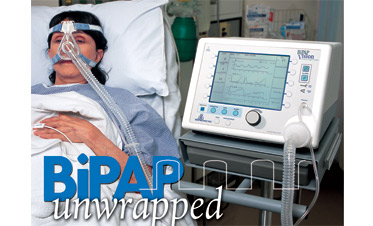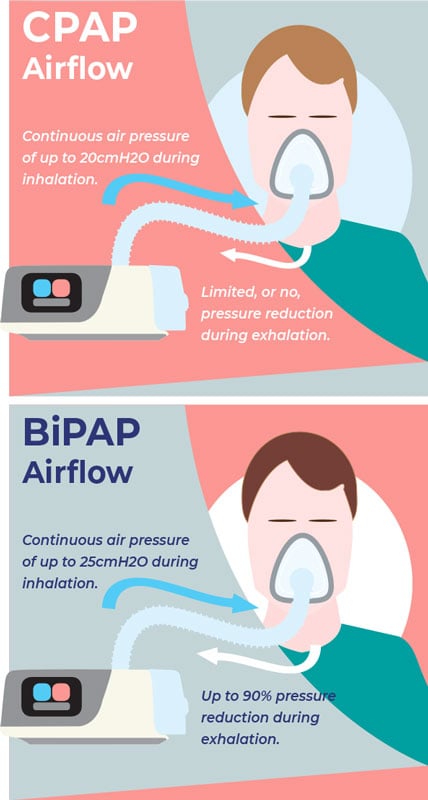Bipap vs. CPAP: Which Is the Best for Your Rest Problem?
When navigating the intricacies of sleep problems, the selection in between BiPAP and CPAP therapy is a crucial factor to consider. Each method supplies special benefits tailored to particular conditions, yet the choice hinges on specific person requirements and comfort degrees. While CPAP supplies a consistent air flow suitable for obstructive rest apnea, BiPAP's double stress setups may enhance convenience for those with even more intricate respiratory issues. Recognizing these distinctions can considerably affect therapy efficiency, leaving one to consider which alternative really aligns with their health needs and way of life.
Understanding Rest Disorders
Rest conditions include a variety of problems that interrupt normal sleep patterns, influencing both the high quality and duration of remainder. These disorders can materialize in numerous types, including sleeping disorders, rest apnea, narcolepsy, restless leg syndrome, and parasomnias. Each problem offers special obstacles, typically bring about significant daytime tiredness, cognitive problems, and emotional disturbances.
Sleep problems is defined by trouble falling or staying asleep, while rest apnea entails repeated disturbances in breathing during sleep, commonly bring about fragmented rest. Narcolepsy, on the various other hand, is noted by excessive daytime sleepiness and sudden sleep assaults. Restless leg disorder creates awkward feelings in the legs, triggering an irrepressible impulse to relocate them, which can likewise hinder the ability to drop off to sleep.
The effect of rest conditions prolongs beyond individual health, influencing general efficiency, partnerships, and top quality of life. Comprehending the details nature of each problem is essential for efficient diagnosis and treatment. As rest health becomes increasingly recognized as a vital part of total health, resolving these problems is vital for improving both sleep quality and day-to-day functioning.
How CPAP Functions
Continual Favorable Air Passage Pressure (CPAP) therapy is frequently used as a main treatment for obstructive sleep apnea (OSA) The system of CPAP involves the usage of an equipment that supplies a constant stream of air via a mask used during rest. This air flow keeps favorable pressure in the airway, preventing the collapse or obstruction of the throat that can occur throughout sleep.
When a patient takes a breath in, the CPAP maker offers a continual circulation of air, making sure that the airway stays open - BiPAP Rental. This not only relieves the signs of OSA, such as snoring and disrupted rest patterns, however also lowers the connected health risks, including cardio complications and daytime exhaustion
The pressure settings on a CPAP equipment can be personalized to fulfill private person demands, commonly identified via a sleep research study. Individuals usually undertake titration research studies to locate the optimal stress level for their special problem. Regular follow-up and modifications may be needed to ensure efficiency and convenience. On the whole, CPAP treatment has actually been revealed to substantially improve the top quality of sleep and total wellness for individuals experiencing from obstructive sleep apnea.
Exactly How BiPAP Functions
BiPAP, or Bilevel Positive Air Passage Stress, is a specific type of non-invasive ventilation that is particularly valuable for people with problems such as intricate rest apnea or breathing problems. Unlike CPAP, which provides a continual stream of air at a solitary stress, BiPAP provides two distinct pressure setups: a greater inspiratory stress for inhalation and a lower expiratory stress for exhalation. This dual-pressure technique enables for less complicated breathing, minimizing the effort required during exhalation.
The gadget runs through a mask fitted over the nose or mouth, attached to an equipment that generates air stress. When the client inhales, the equipment supplies the greater pressure to assist with air movement, ensuring that the air passage remains open. Upon exhalation, the equipment instantly minimizes the stress, making it a lot more comfy for the person to breathe out.

Trick Differences Between BiPAP and CPAP

On the other hand, BiPAP (Bilevel Positive Air passage Stress) offers two various stress setups: one for inhalation and a lower one for exhalation. This double stress system enables even more comfy breathing, specifically for clients who deal with exhaling against a constant stress. BiPAP is frequently advised for patients with complex sleep apnea, chronic obstructive pulmonary illness (COPD), or those that call for added assistance throughout rest.
Moreover, the complexity of BiPAP tools generally causes a greater price and calls for more careful titration than CPAP. BiPAP Rental. Understanding these essential differences can help in acknowledging which gadget may be better for details rest problems, establishing the groundwork for enlightened therapy choices
Selecting the Right Therapy
The choice in between BiPAP and CPAP therapy mainly pivots on the certain attributes of the sleep condition, the client's overall wellness, and their comfort with the tool. CPAP, which provides a constant stream of air, is typically prescribed for obstructive rest apnea (OSA)
Conversely, BiPAP gives two degrees of stress: one for breathing and a reduced one for exhalation. This double pressure system is useful for patients with intricate sleep apnea or those that experience trouble exhaling versus a continual stress. Additionally, BiPAP is frequently advised for individuals with breathing problems, such as persistent obstructive pulmonary illness (COPD), where differing stress settings can improve convenience and compliance.
Inevitably, a detailed assessment by a rest professional, including a rest research study, can assist determine which treatment straightens best with the this website individual's needs. Aspects such as convenience, ease of use, and details medical problems ought to likewise be taken right into consideration to maximize treatment results.
Conclusion
In summary, both BiPAP and CPAP offer distinctive objectives in the management of sleep disorders. CPAP works for obstructive rest apnea via regular air movement, while BiPAP offers twin pressure settings that enhance comfort for those with complex sleep apnea or breathing problems. The site web option between these therapies ought to be assisted by specific demands and problems, requiring a detailed assessment by a rest expert to guarantee optimal therapy outcomes and improved high quality of rest.

Generally, CPAP treatment has actually been shown to dramatically improve the quality of sleep and general wellness for individuals enduring from obstructive sleep apnea.
BiPAP is usually advised for clients with complicated rest apnea, chronic obstructive lung disease (COPD), or those that call for added assistance throughout rest.
CPAP is effective for obstructive rest apnea with constant air movement, while BiPAP supplies twin stress settings that enhance comfort for those with complex rest apnea or breathing concerns.
Comments on “Necessary Tips for Picking a BiPAP Rental Solution”